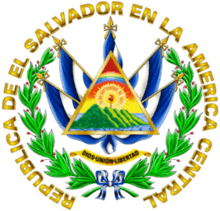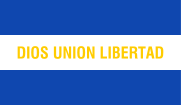Flag of El Salvador
 | |
| Name |
Tierra de Volcanes Soberbios "Land of Arrogant Volcanoes" (in Spanish) |
|---|---|
| Use | State and war flag, naval ensign |
| Proportion | 189:335 |
| Adopted | May 27, 1912 |
| Design | A horizontal triband of blue (top and bottom) and white with the National Coat of Arms centered on the white band. |
|
Variant flag of El Salvador | |
| Use | Civil flag |
| Proportion | 3:5 |
|
Variant flag of El Salvador | |
| Use | State and war flag, civil and state ensign |
| Proportion | 3:5 |
The flag of El Salvador was inspired by the flag of the Federal Republic of Central America and Greater Republic of Central America entities.
Features

The colors signify:
- Golden Amber : represents the entire bold phraseology in the flag, the coat of arms of El Salvador; the bold equilateral triangle, 5 indigenous spears, beaming solar rays, scroll, the bold motto (God Union Liberty) and the bold etymology (Republic of El Salvador in Central America)
There are two versions of the flag, one containing the national coat of arms with the words "REPUBLICA DE EL SALVADOR EN LA AMERICA CENTRAL" (English: Republic of El Salvador in Central America), and the other with the words "DIOS UNION LIBERTAD" (English: God, Union, Liberty); both have the words in amber. The one bearing the coat of arms is used by the government and state organizations. The other version is used for civil purposes. Both contain the same cobalt blue and white stripes and both flags have a 3:5 aspect ratio.
From 1865 to 1912, a different flag was in use, with a field of alternating cobalt blue and white stripes and a red canton containing white stars. The designs of both sides of the flag are different; at the reverse side, it shows the then national coat of arms at the position of stars at obverse. The stars symbolized the provinces of the Republic; once a new province was created, one star was add to the obverse of the flag. This "Star-Striped" banner was considered to be inspired by the flag of the United States.
The blue stripes symbolize the ocean and sky. The white means Peace.


Blue is an important color in Salvadoran culture and identity. It started with Native American cultures of Mesoamerica in El Salvador, that cultivated and produced (añil) indigo plant which they used extracts to produce blue dyes. When the Europeans invaded and colonized the area, they saw the wealth of indigo and turned El Salvador to one of the world's foremost providers of indigo dye in its time. Synonymous to the country's wealth, the colonizers referred to the dye as "the blue gold", that dominated El Salvador's economy until it was completely replaced by coffee cultivation. Today El Salvador remains as one of the few countries in the world that still cultivates indigo to produce blue dyes. Over time El Salvador's flag has had several different shades of blue, from the lightest to darkest. The present current modern flag displays a Cobalt Blue tone.
 Feb. 20, 1822 - Feb. 10, 1823, 1841 - 1842, 1844 - May 9, 1865 (as part of United Provinces of Central America) (civil flag)
Feb. 20, 1822 - Feb. 10, 1823, 1841 - 1842, 1844 - May 9, 1865 (as part of United Provinces of Central America) (civil flag) Aug. 21, 1823 - 1824, 1842 - 1844 (as part of United Provinces of Central America)
Aug. 21, 1823 - 1824, 1842 - 1844 (as part of United Provinces of Central America) 1824 - 1841,1921 - 1922 (as part of Federal Republic of Central America)
1824 - 1841,1921 - 1922 (as part of Federal Republic of Central America).svg.png) May 9 - June, 1865
May 9 - June, 1865.svg.png) June, 1865 - 1869
June, 1865 - 1869.svg.png) 1869 - 1873
1869 - 1873.svg.png) 1873 - 1877
1873 - 1877.svg.png) 1877 - May 17, 1912
1877 - May 17, 1912 Nov. 2 - Nov. 30, 1898 (as part of Greater Republic of Central America)
Nov. 2 - Nov. 30, 1898 (as part of Greater Republic of Central America)- Flag of El Salvador (1865-1877)(Reverse side)
- Flag of El Salvador (1877-1912)(Reverse side)
 Flag of El Salvador (1912-Present)
Flag of El Salvador (1912-Present)


